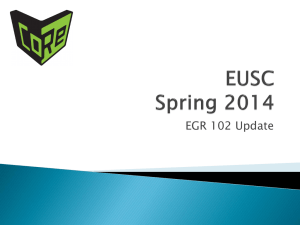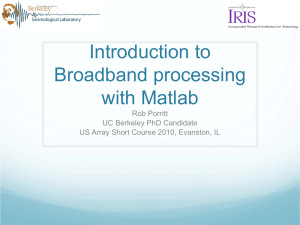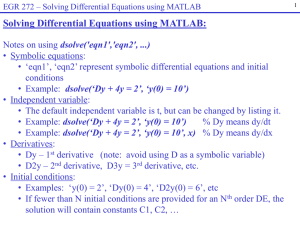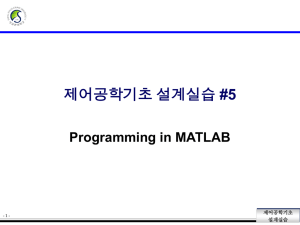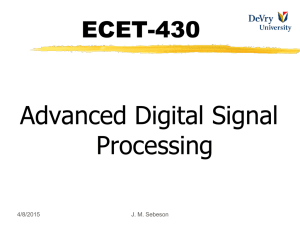Frequency Response
advertisement
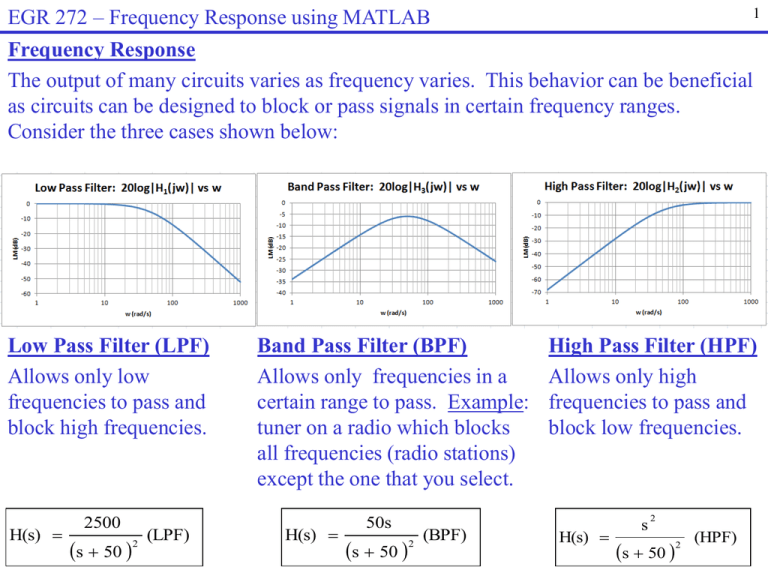
1
EGR 272 – Frequency Response using MATLAB
Frequency Response
The output of many circuits varies as frequency varies. This behavior can be beneficial
as circuits can be designed to block or pass signals in certain frequency ranges.
Consider the three cases shown below:
Low Pass Filter (LPF)
Allows only low
frequencies to pass and
block high frequencies.
H(s)
2500
s 50
2
(LPF)
Band Pass Filter (BPF)
Allows only frequencies in a
certain range to pass. Example:
tuner on a radio which blocks
all frequencies (radio stations)
except the one that you select.
H(s)
50s
s 50
2
(BPF)
High Pass Filter (HPF)
Allows only high
frequencies to pass and
block low frequencies.
H(s)
s
2
s 50 2
(HPF)
EGR 272 – Frequency Response using MATLAB
Transfer Functions: Determining the frequency response begins with finding the
transfer function, H(s). H(s) is defined as follows:
H(s)
Y(s)
X(s)
Input = x(t)
Circuit
or
System
Output(s)
Input(s)
y(t) = Output
Time-domain representation of a circuit or system
Input = X(s)
H(s)
Y(s) = Output
s-domain representation of a circuit or system using a transfer function H(s)
2
EGR 272 – Frequency Response using MATLAB
Graphing frequency response - Procedure:
1. Form H(jw) by replacing s with jw in H(s).
2. Since H(jw) is a complex function it can be expressed in polar form with a
magnitude and an angle as follows: H(jw) = |H(jw)| (w)
3. Frequency response is generally illustrated by graphing one of the following:
1. Magnitude response: Graph of |H(jw)| vs w
2. Log-Magnitude (LM) response: Graph of 20 log |H(jw)| vs w
3. Phase response: Graph of (w) vs w
Note that |H(jw)| is typically a unitless quantity (|Vo/Vin| or |Io/Iin| for example), but
20 log |H(jw)| has the units of decibels, dB.
3
4
EGR 272 – Frequency Response using MATLAB
Example:
2500
H(s)
s 50 2
For the transfer function above, find H(jw) and graph the LM response and the phase
response using MATLAB. Let w vary from 1 to 1000 rad/s.
Note: This is the exact function used to form the LM response for the LPF on the first
slide.
Solution
:
H(jw) H(s)
LM response
s jw
2500
jw
50
2
is a graph of 20log( H(jw) ) vs w
Phase response
See MATLAB
is a graph of phase(H(jw
)) vs w
solution
Recall that in MATLAB we can use the functions:
abs( ) - finds the magnitude of a complex number (or transfer function)
angle( ) – finds the phase of a complex number (or a transfer function)
EGR 272 – Frequency
Response using MATLAB
5
EGR 272 – Frequency Response using MATLAB
Class Example: Use MATLAB to graph the LM and phase response for the transfer
function below. Use a technique similar to the last example using the abs( ) and
angle( ) functions.
H(s)
50s
s 50 2
Note: This is the exact function used to form the LM response for the BPF on the first
slide.
6
EGR 272 – Frequency Response using MATLAB
Functions in MATLAB for frequency response
Frequency response is such an important topic in EE that some special functions are
available in MATLAB to make finding frequency response easier. In EGR 272 we
introduce Bode plots as good approximations for frequency response. We often find:
• Bode LM plot
• Bode phase plot
Oddly, the function bode( ) in MATLAB can be used to find exact frequency response
plots (not approximations). Consider the functions described on the following slide:
7
EGR 272 – Frequency Response using MATLAB
MATLAB functions useful for finding frequency response
8
tf(N,D) – finds a transfer function given a numerator, N, and a denominator, D,
(expressed as polynomials)
Example:
N = [1 20]; // represents the numerator (s + 20)
D = [1 100]; // represents the denominator (s + 100)
H = tf(N,D); // forms (and displays) the transfer function H = (s + 20)/(s + 100)
bode(H) – creates LM and phase plots for transfer function H over a range of frequency
selected by MATLAB
bode(H,w) – similar to bode(H), but uses the range of frequency, w, specified by the
user. For example, the user might specify: w = logspace(2,4,50);
bode(H,{w1,w2}) – similar to bode(H), but uses the frequency range from w1 to w2.
freqresp( ) – can be used to generate a vector a points for frequency response, but we
won’t use it here as bode( ) is more convenient.
EGR 272 – Frequency Response using MATLAB
Example: Repeat the
earlier example of
graphing the LM and
phase responses for
H(s), but use the tf( )
and bode( ) functions.
H(s)
2500
s 50 2
Output from
tf( ) command
9
10
EGR 272 – Frequency Response using MATLAB
Class Example: Use MATLAB to graph the LM and phase response for the transfer
function below using the tf( ) and bode( ) functions. Note that the results should match
an earlier example.
H(s)
50s
s 50 2


